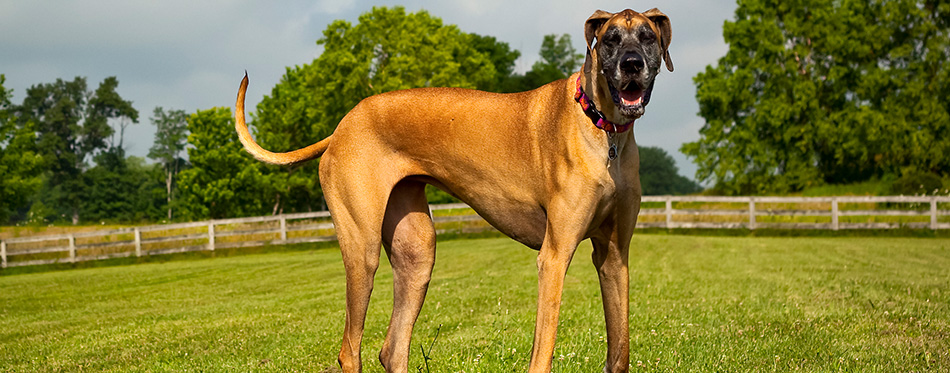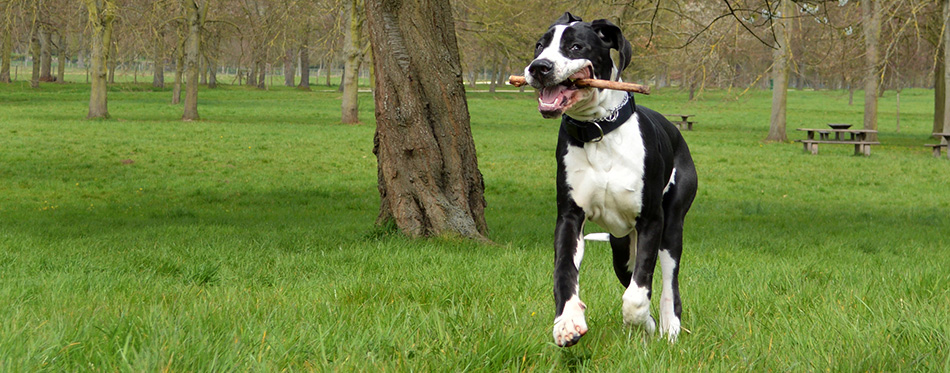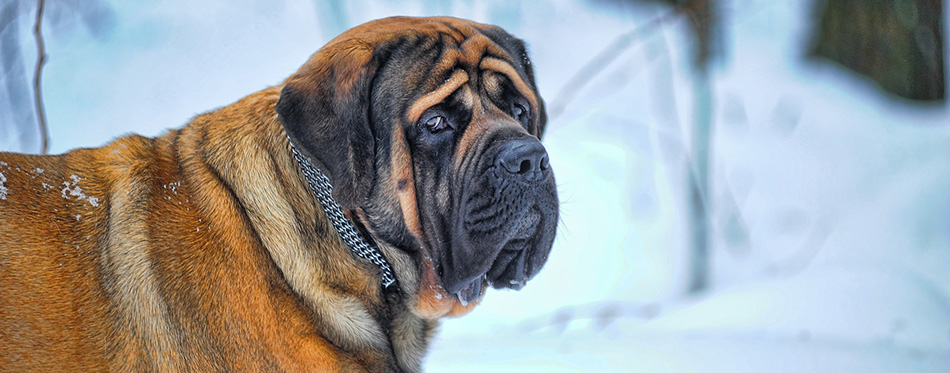Families who adopt dogs love them, and their canine friend does well in returning the love unconditionally. However, when the pooch in question is a giant breed with a liking for licks and laps, it is a totally different experience altogether. The Daniff belongs to that category, a cross between the English Mastiff and the Great Dane, the giant dog is an absolute sweetie that displays unflinching love for its family and will go the extra mile for its adopters. This great canine loves to mingle with other creatures both humans and animals, but it suffers from separation anxiety, and thus, it is affected by protracted severance from its family.
Naturally, the pooch does not sit for long as it loves activity and the best part of the canine’s nature is its friendly but protective disposition which makes it the perfect pet as well as a companion. Continue reading to get the necessary information on the breed’s origin, including other details like health, grooming as well as training.

History of the Daniff (Great Dane and Mastiff Mix)
Before you can completely understand the Daniff, you have to clearly appreciate the ancestry of the dog’s parents, which are the Mastiff and the Great Dane. This is of utmost importance since it has been established that the Daniff has 50 percent trait from each parent. Hence the need to completely study each of them,
Just like other crossbred animals, The Daniff’s history is difficult to establish, the only certainty about them is that both the Mastiff and the Great Dane are believed to be ancient dogs and this points to the fact that The Great Dane Mastiff Mix is not likely to be completely new. The dog is registered as well as recognized by the International Designer Canine Registry or IDCR, though Kennel organizations like the American Kennel Club or others that fall under the auspices of Federation Cynologique Internationale or FCI as well as the World Canine Organization are yet to register the breed. However, the Daniff was officially recognized as a designer dog by the International Organization of Hybrid or Crossbred Dogs in 2009.
The crossbreeding project between the Mastiff and the Great Dane may have taken off within the last ten years of the 20th century. Both the Mastiff and Great Dane had their own distinctive history and characteristics detailed below;
The Great Dane: As one of the world’s largest breeds, the Great Dane reaches a shoulder height of up to eighty centimeters and a weight of up to 95 kilograms, with males becoming significantly heavier than females. It is a huge dog, and despite its massive size, it is a lap dog by nature, very friendly, devoted as well as loving. The pooch can cuddle up with its owner to watch television all day. It is one of those huge dogs that will feel comfortable in a small home since it does not require too much exercise. Because of the name, many people have come to believe that the Great Dane is of Denmark origin, but this is not true. The breed originated from Germany and owes it characteristic as well as existence to huge dogs such as the Greyhound, the Mastiff, and also the Irish Wolfhound. These breeds are the source of the Great Dane’s distinguishing heft, height, and sleek physique. However, it is possible to trace the breed’s ancestry to the Tiryns of prehistoric Greece which was during the fourteenth to thirteenth century BC. They were called the boarhounds. The Great Dane came into existence during the middle of the sixteenth century through a crossbreeding project between the English Mastiff and the Irish wolfhound.
The Mastiff: Just like the Great Dane, the English Mastiff is also endowed with great size, a gigantic dog, with the female of the species growing up to 180 pounds, while the male is likely to grow as much as 250 pounds. When it comes to height, the Great Dane may come taller, but the Mastiff is physically equipped with an exceptional appearance that is well-muscled as well as beefier. The head is huge, characterized by a black mask, and the coat is shorter when compared to other breeds.
According to general belief, the Mastiff originated from the large ancient dogs from Central Asia and has been functioning as guarding, fighting and hunting dogs for thousands of years. In fact, nomads and traveling merchants majorly from Tibet and Northern part of India use the breed as their preferred security. History has it that it was thanks to these travels that the breed came into other parts of the world like Russia, the Middle East, the Mediterranean, and China. Many Egyptian relics from archeological findings depict dogs of giant sizes. Moving into Greek Mythology, you will encounter the three-headed guard dog of the underworld that had mastiff-like traits and features. The breed was used as a battle dog by some civilizations like the Greek and the Romans among others.
Quick Facts About the Daniff (Great Dane and Mastiff Mix)
Creating a mental picture of the possible physical attributes of the progeny of the globe’s biggest breeds of dogs would be quite easy. But if you lack the imaginative powers, here are some quick facts about the Great Dane and Mastiff Mix.
- The shoulder statistics for both parents can exceed 30 inches, which makes it possible for the Daniff to grow within the range of 30 – 34 inches.
- Though the Great Dane comes lighter than the Mastiff, both breeds weigh higher than 150 pounds, and according to the International Designer Canine Registry, the two can weigh between 115 to 130 pounds on average. Though several dogs have been known to weigh as much as 195 pounds and sometimes up to 210 pounds.
- If it is exposed to the right nutrition and care, the Daniff can survive for up to 10 years, but regrettably, their life span hardly gets to a decade which is usually the case for all large breeds. They may last for about five to six years.
- The coat for the Danish is relatively short and thus will not need much brushing or grooming.
- A model 50-50 split between a Mastiff and a Great Dane would likely be a Daniff with a physique that is just right – not too huge and not too lanky.

Things You Should Know About the Daniff (Great Dane and Mastiff Mix)
The Daniff breed is not for everybody; the dog is only suitable for a select few, they include;
people that love to keep giant lap dogs that don’t need much in the way of strenuous exercise, people that are averse to grooming and brushing their pooch regularly, families with kids that are from eight years and above, and those that want a watchdog that also functions as a guard dog, but never an attack dog. If you happen to be the type who does not like to have their pet slobbering over them and perhaps you are averse to training as well as socializing puppies, then the Daniff is not suitable for you. Here are a few more things you should know of the Daniff.
Health
As with other aspects of the Daniff Cross, the lifespan of the Great Dane Mastiff Mix and all inheritable health problems depend on the genetics it inherits from its parent breeds. Just in the same way as other canines that are hybrid, the Daniff is likely to have inherited some diseases that most likely fail the parents. However, predicting an individual canine’s long-term-health condition is rather difficult, since each breed is unique. And besides whether any of those health conditions were passed down to the Daniff is not guaranteed, and you have to consider the fact that hybrids have the propensity to be surprisingly resilient as well as tough, even better than their parents.
Also, keep in mind that an early check-up procedure is a good option if you are worried about the long-term health of your Daniff dog. Generally, life expectancy for the breed is within the range of 6 to 12 years, though they are known to be susceptible to health conditions like hip and elbow dysplasia, bloat, cancer, heart problems, skeletal problems, eye ailments, and hypertrophic osteodystrophy. Out of all the physical ailments, the most common are heart problems and hip dysplasia, though bloating also shows up from time to time. Here are a few more health aspects to be aware of;
- The Daniff is such a big cross that it is more susceptible to muscle and skeletal problems as it grows.
- To help with its development, the dog should receive high-quality dog food that is specifically geared to large pedigree dogs.
- It should also eat foods that are indicated for its age.
Related Post: Flea Collars for Dogs
Training
When it comes to training, both parents of the Daniff are rather too stubborn to obey the commands of training. Because of this trend, people expect the same from their hybrid. But then you can do well to commence training early for the Daniff in order to ensure that it responds to instructions. However, if you happen to find it impossible to manage your pooch, or perhaps you lack the basic skills in dog training, you may consider hiring the services of a professional dog trainer. Early socialization ensures that the breed starts acclimatizing to the rules of the house immediately, and it will also ensure its comfort in the company of people and other house pets.
Out of all the breeds of canine, both the Mastiff and the Great Dane are believed to be averagely intelligent, which can add spice to the challenge of training. Though many kinds of literature have actually said that the Daniff is really an intelligent breed, but in any case, early training is the key.
Though the dog will eventually grow into a giant-sized pooch, it will still be very small as a puppy, so you have to insure its safety by keeping the puppy in a place where it is not likely to be injured. Close supervision is recommended while the little puppy is interacting with kids.
Exercise
- The exercise needs of both the Mastiff and the Great Dane are below average; they should be good with just 30 minutes of walking on a daily basis. Same is true for the Daniff, though recommendations are that you commence with a twice-daily walking exercise which will take up to 30 minutes for one session, and while you are at it, you should do well to mix it with some mental exercise.
- While the breed’s parents were seen as hunting dogs in the past era, the present-day Daniff are just oversized lap dogs. Even so, exercise is still needed.
- During its development, the Daniff may be particularly susceptible to skeletal or muscle injuries. Make sure he is not over exercised and that he is being watched while climbing the stairs.
- While training this huge intersection should not be too difficult, the mastiff could easily get bored in it. If your Daniff dog falls asleep while exercising, do not take him personally. It’s in its blood!
Nutrition
Since the Daniff is such a giant dog, you need to take care of its daily nutritional requirement by providing it with enough food. On the other hand, overdoing it might result in overweight which may pose another set of problems, so you need to watch it. Again, the big dog is susceptible to bloat, which you really have to try and prevent. Recommendations from experts approve smaller, but frequent feedings for the dog. Feeding time for dogs of average size can come a couple of times a day, but for the Daniff, you can up it to three or four times on a daily basis with the mealtime evenly spaced out.
The amount of nutrients and calories that you feed the dog should be proportionate to its needs. Many dog parents prefer to feed their pooch with some dry dog food of high-quality, especially those that have whole food ingredient without any form of artificial ingredients or allergens.
Regular fresh and clean water should be provided, and in a bid to add some variety to their pet’s diets, many adopters include some good quality canned canine food. However, taking this route only means that you will have to cut down on the quantity of dry food to avoid overfeeding.
For more guides on choosing the right dog food, you may wish to check out our reviews of the best dry dog food, organic dog food, grain free dog food, wet dog food and puppy food.

Grooming
The breed’s short coat is a great advantage as it won’t have to bother with losing too much hair during the shedding season. It is usually enough to brush the coat a couple of times a week and if you consider it too much of a stress, once is still good enough. The baths will have to come when it is necessary, and one advantage that the Daniff has over its parents is that it does not drool as much as them.
For more help on dog grooming, you may wish to read our guides on the best dog nail grinders, dog dryers, dog clippers, dog paw washers and dog shedding brushes.
Temperament
Being the progeny of two giants who are reputed to be gentle, it is only natural that the Daniff draws its loving and placid disposition from the parents, though many people have stated that it drew 50/50 character trait from each of them, it is not really easy to tell if one is dominant. The breed’s temperament is best described as energetic and playful; despite its enormous height, it is a very affectionate and discreet dog who likes to be in close proximity to its owners, but is not submissive. If a Daniff is consistently socialized from puppy age on, it is also very compatible with children and other pets. Its pronounced protective instinct makes it an excellent guard dog, who defends the house and family vehemently, but can also be very territorial. Caution is especially necessary because this breed also tends to aggression and although it can easily adapt well to children, it is not recommended for homes that still have very young kids like toddlers, as the massive size of the pooch is enough to crush a little kid. Whenever the dog is interacting with children, a close watch is recommended; besides, the breed blends well with other house pets.
As mentioned, the dog’s devotion and loyalty to the family that adopts it is best described as unflinching and unquestionable. No matter the situation, it will protect and defend its family, the dog hardly barks except when provoked. However, this can definitely be prevented by a consistent education and loving attention. In fact, it is the ideal watchdog displaying the very same characters that its parents were appreciated for, in the past era. Nothing is more important to the Daniff than to alert its adopters to the presence of danger or strangers and with that colossal size the pooch is capable of sending people with bad plans on their way. Just like the Great Dane, the Daniff has an excellent memory and can be very vindictive. However, those who respectfully treat their Daniff will find a very loyal companion.

